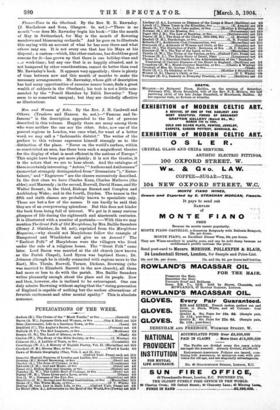Men and Women of Soho. By the Rev. J. H.
Cardwell and Others. (Truslove and Hanson. 6s. net.)—" Famous and In- famous" is the description appended to the list of persons described in this volume. Happily there are many among them who were neither the one nor the other. Soho, now one of the poorest regions in London, was once what, for want of a better word, we may call a "fashionable district." The writer of the preface to this volume expresses himself strongly as to the distinction of the place. "Never on the world's surface, within
• so constricted an area, has there been such a magnificent theatre
• for the display of what is most efficient in the nations of Europe." - This might have been put more plainly ; it is not the theatre, it is the actors that we are to hear about. And the catalogue of these is certainly interesting. " Actors," " Authors and Authoresses" (somewhat strangely distinguished from" Dramatists "), "Enter- tainers," and " Engravers " are the classes successively described. In the first class we have Charles Kean, Charles Mathews (the .elder), and Macready ; in the second, Boswell, David Hume, and Sir Walter Besant ; in the third, Bishops Burnet and Compton and Archbishop Wake ; and in the fourth, Dryden. The names in the fifth and sixth classes are probably known to specialists only. These are but a few of the names. It can hardly be said that they are of an overpowering splendour. But this does not hinder the book from being full of interest. We get in it many curious glimpses of life during the eighteenth and nineteenth centuries. It is illustrated with a number of portraits.—With this we may mention The G-reat Folk of Old Marylebone, by Mrs. Baillie Saunders (Henry J. Glaisher, 2s. 6d. net), reprinted from the Marylebone Magazine,—why should not Marylebone follow the example of Hampstead and Wimbledon and give us an Annual ? The "Earliest Folk" of Marylebone were the villagers who lived under the rule of a religious house. The "Great Folk" came later. Lord Bacon was married at the old church (now known as the Parish Chapel), Lord Byron was baptised there ; Dr. -Johnson (though be is chiefly connected with regions more to the East), Mrs. Thrale, Boswell, Turner, Dickens, Browning (who was married to Elizabeth Barrett in the new church), all these had more or less to do with the parish. Mrs. Baillie Saunders writes pleasantly enough about the place and its people. Now and then, however, she is inclined to be extravagant. One can duly admire Browning without saying that the " rising generation of England is capable of nothing but the useless alternations of feverish excitement and utter mental apathy." This is absolute nonsense.










































 Previous page
Previous page